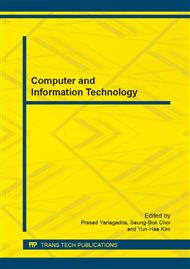[1]
G. Li: LFMCW Life Detecting Radar and Signal Processing (Northwestern Polytechnical University, 2007).
Google Scholar
[2]
S.E. Borek, in: An overview of through the wall surveillance for homeland security, Proceedings of the 34th Applied Imagery and Pattern Recognition Workshop, Vol. 19-21 (2005), pp.43-47.
DOI: 10.1109/aipr.2005.18
Google Scholar
[3]
D.D. Ferris, J. Nicholas and C. Currie, in: A Survey of Current Technologies for Through the Wall Surveillance, Proc. SPIE (1998).
Google Scholar
[4]
G.H. Lu, J.Q. Wang and G.S. Yang, in: Research Status of Biological Radar, International Journal of Biomedical Engineering, Vol. 27 (2004), pp.368-370.
Google Scholar
[5]
E. F. Greneker, in: Radar Flashlight for Through-the-wall Detection of Humans, SPIE Conference on Targets and Backgrounds, Characterization and Representation IV (1998), pp.280-285.
DOI: 10.1117/12.327172
Google Scholar
[6]
K.M. Chen, Y. Huang, J. Zhang and Nbnnan, in: A Microwave Life-detection Systems For Searching Human Subject Under Earthquake Rubble or Behind Buried, IEEE Tans Biomed Eng., Vol. 47 (2000), pp.105-114.
DOI: 10.1109/10.817625
Google Scholar
[7]
M. BimPas, N. Paraskevopoulos and K. Nikellis, in: Development of a Three Band Radar System for Detecting Τapped Alive Humans under Building Ruins, Progress in Electromagnetics Research (2004).
DOI: 10.2528/pier04030501
Google Scholar
[8]
A.S. Bugaev, in: Through Wall Sensing Of Human Breathing and Heart Beating by Monochromatic Radar, Tenth International Conference on Ground Penetrating Radar(2004).
Google Scholar
[9]
S. Azevedo, Thomase and Mcevan, in: Micropower Impulse Radar, Science and Technology Review (1996), pp.16-29.
Google Scholar
[10]
H. Song, Y. Li, in: Detection Technology of Moving Target UWB wall radar, Telecommunications Technology, Vol. 06 (2004), pp.134-138.
Google Scholar
[11]
A.A. Vertiy, I. v. voynovskyy and S. Ozbek, in: Microwave through-obstacles life-signs detection system, The Remote Sensing Laboratory Annual (2005).
Google Scholar
[12]
D. D. Ferris, N. C. Currie, in: Microwave and millimeter wave systems for wall penetration, SPIE Conference on Targets and Backgrounds: Characterization and Representation IV (1998), pp.269-279.
DOI: 10.1117/12.327159
Google Scholar
[13]
C. P. Lai, in: Through Wall Surveillance Using Ultra Wide Band Random Noise Radar, The Pennsylvania State University (2007).
Google Scholar
[14]
Z. J. Liu, L. B. Liu, B. M. Barrowes, in: The Application of the Hiblert-Huang transform in Through-wall life Detection with UWB Impulse Radar, PIERS ONLINE, Vol. 6 (2010), pp.695-699.
DOI: 10.2529/piers100217122115
Google Scholar
[15]
S. Shravan, B. Paramita, D. Anuradha, R. Kuloor, in: Heart-beat Detection and Ranging Through a Wall using Ultra Wide Band Radar, International Conference on Communications and Signal Processing(2011), pp.579-583.
DOI: 10.1109/iccsp.2011.5739391
Google Scholar
[16]
J. Li, Z. F. Zeng, J. G. Sun and F. S. Liu, in: Through Wall Detection of Human Being's Movement by UWB Radar, IEEE Geoscience and Remote Sensing Letters, Vol. 9 (2012), pp.1079-1083.
DOI: 10.1109/lgrs.2012.2190707
Google Scholar
[17]
A. S. Ni: Life Recognition Technology in Wounded Detection (Fourth Military Medical University, 2003).
Google Scholar
[18]
Y. Zhang, Y. Jiao, X. J. Jing, X. Yu, J. Q. Wang, in: Interference Suppression of Environment Moving Target for Life Detecting Radar, Fourth Military Medical University, Vol. 36(2010), pp.52-55.
Google Scholar
[19]
M. H. Mu: Waveform Design and Interference Suppression of UWB Life Detecting Wall Radar (National Defense University, 2009).
Google Scholar
[20]
J. J. Ren: Wall Modeling and Detection Technique of UWB Signals (China University of Science and Technology, 2012).
Google Scholar


